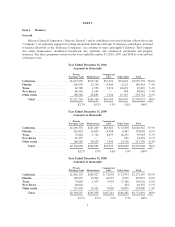Mercury Insurance 2010 Annual Report Download - page 21
Download and view the complete annual report
Please find page 21 of the 2010 Mercury Insurance annual report below. You can navigate through the pages in the report by either clicking on the pages listed below, or by using the keyword search tool below to find specific information within the annual report.
Insurance rates in Georgia, New York, New Jersey, Pennsylvania, and Nevada require prior approval from
the state DOI, while insurance rates in Illinois, Texas, Virginia, Arizona, and Michigan must only be filed with
the respective DOI before they are implemented. Oklahoma and Florida have a modified version of prior
approval laws. In all states, the insurance code provides that rates must not be excessive, inadequate, or unfairly
discriminatory.
The DOI in each state in which the Company operates is responsible for conducting periodic financial and
market conduct examinations of the Insurance Companies in their states. Market conduct examinations typically
review compliance with insurance statutes and regulations with respect to rating, underwriting, claims handling,
billing, and other practices. The following table presents a summary of current financial and market conduct
examinations:
State Exam Type Period Under Review Status
OK Financial 2008 to 2010 Fieldwork will begin in the first quarter of 2011.
OK Market Conduct 2007 to 2009 Fieldwork will begin in the first quarter of 2011.
CA Financial 2008 to 2010 Fieldwork began on January 31, 2011.
FL Financial 2005 to 2009 Received final report on February 4, 2011.
TX Financial 2005 to 2009 Received final report draft on December 20, 2010.
TX Market Conduct Mar 2009 to Feb 2010 Received final report on September 29, 2010.
IL Market Conduct Jul 2009 to Jun 2010 Fieldwork completed. Awaiting final report.
IL Financial 2005 to 2009 Fieldwork began on August 30, 2010.
During the course of and at the conclusion of these examinations, the examining DOI generally reports
findings to the Company, and none of the findings reported to date is expected to be material to the Company’s
financial position.
For discussion of current regulatory matters in California, see “Regulatory and Legal Matters” in “Item 7.
Management’s Discussion and Analysis of Financial Condition and Results of Operations.”
The operations of the Company are dependent on the laws of the states in which it does business and
changes in those laws can materially affect the revenue and expenses of the Company. The Company retains its
own legislative advocates in California. The Company made financial contributions of $133,350 and $148,200 to
officeholders and candidates in 2010 and 2009, respectively. The Company believes in supporting the political
process and intends to continue to make such contributions in amounts which it determines to be appropriate.
The Company supported the Continuous Coverage Auto Insurance Discount Act (“Proposition 17”), a
California initiative on the June 2010 ballot which did not pass. It would have provided for a portable persistency
discount, allowing insurance companies to offer new customers discounts based on having continuous insurance
coverage from any insurance company. Currently, the California DOI allows insurance companies to provide
persistency discounts based on continuous coverage only with existing customers. The Company made financial
contributions of $12.1 million and $3.5 million in 2010 and 2009, respectively, related to this initiative. The
Company continues to offer a competitive product in California.
Risk-Based Capital
The Insurance Companies must comply with minimum capital requirements under applicable state laws and
regulations, and must have adequate reserves for claims. The minimum statutory capital requirements differ by
state and are generally based on balances established by statute, a percentage of annualized premiums, a
percentage of annualized loss, or risk-based capital (“RBC”) requirements. The RBC requirements are based on
guidelines established by the NAIC. The RBC formula was designed to capture the widely varying elements of
risks undertaken by writers of different lines of insurance having differing risk characteristics, as well as writers
11
























